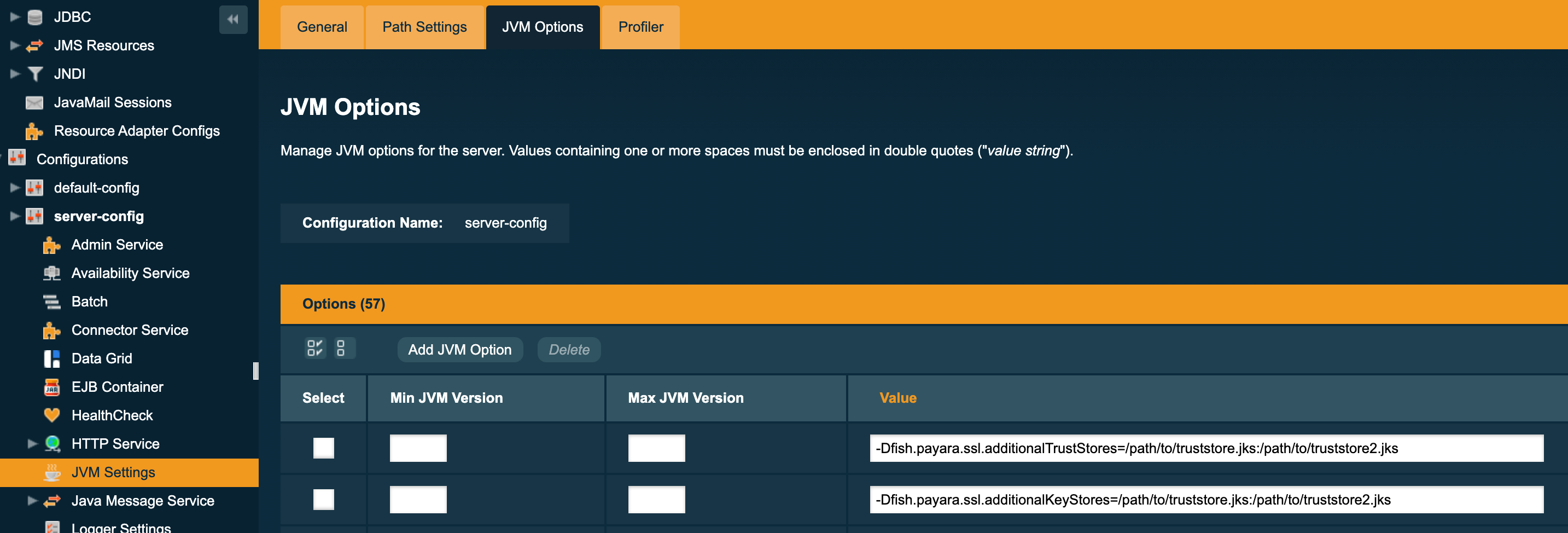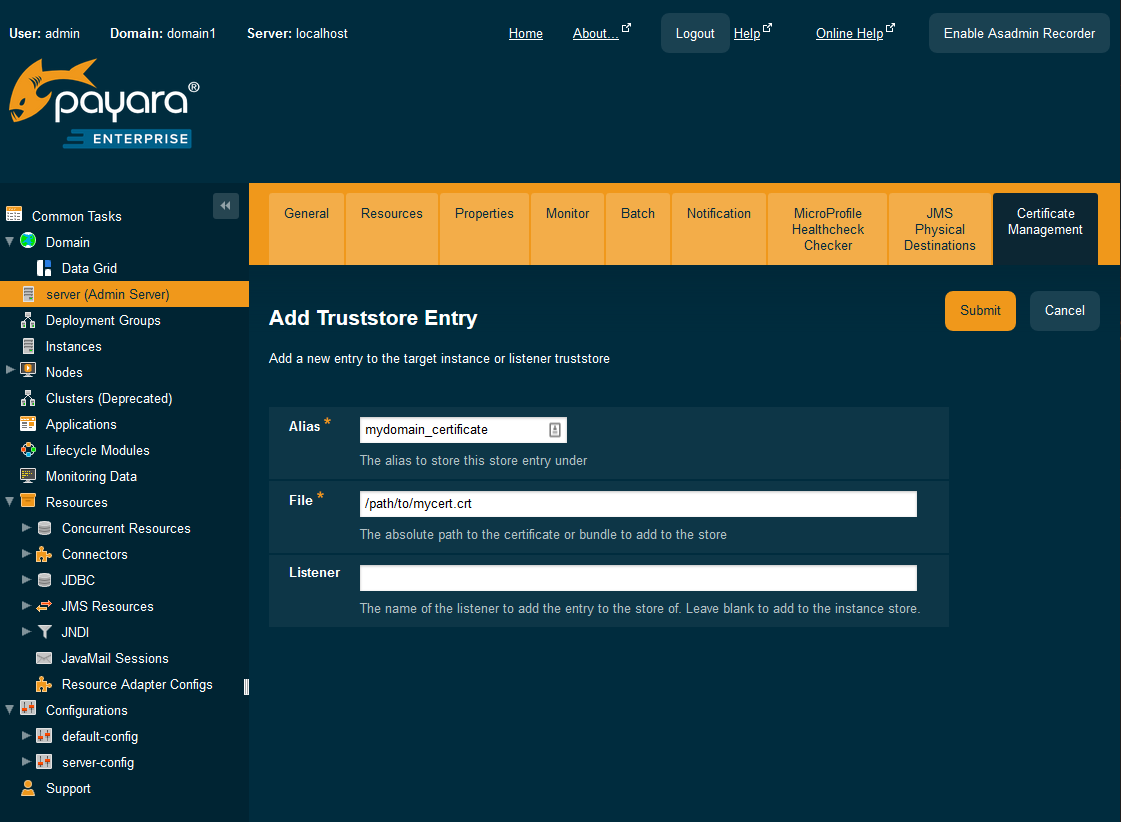Configure SSL Certificates
Payara Server uses a dedicated key and certificate store when using SSL/TLS connections. The files are located in the configuration directory of the domain <payara-home>/glassfish/domains/<domain-name>/config and referenced through JVM options so that they are used for the entire JVM.
keystore.p12-
Java Keystore formatted file containing the Cryptographic keys, like the private keys associated with the certificates.
cacerts.p12-
Java Keystore formatted file used as Trust Store file holding the X.509 certificates.
These keystores are protected with the Master Password of your domain.
| From Payara version 6.2023.2 and later the keystores were migrated from JKS to PKCS12 format. |
Adding SSL Certificate
To add your SSL Certificate to the Payara Server configuration files, you need:
-
The private key associated with your certificate.
-
The Certificate you received from the Certificate Authority based on your Certificate Signing Request (CSR).
You can generate a self-signed certificate using the command detailed here
asadmin generate-self-signed-certificate --dn "CN=test.payara.fish,IP=127.0.0.1" mydomain_certificate- Alternatively
-
You can find the detailed steps of adding a self-signed certificate into Payara Server for testing purposes using
keytoolandopensslin the blog Securing Payara Server with Custom SSL Certificate.
The private key can be stored in various formats. We assume that the key is in a format which can be read by the Java key tool program, such as PKCS#8 (file starts with BEGIN ENCRYPTED PRIVATE KEY)
In a first step (if following the blog), we combine the Private key and the Certificate we received into a file. This file can then be used to merge our data into the files used by the Payara Server installation.
In this step, we also specify an alias name for our key/certificate. This alias name is important as we will use it later to refer to our specific SSL Certificate.
The command to perform this combination is the following with OpenSSL:
openssl pkcs12 -export -in mycert.crt -inkey mycert.key -out mycert.p12 -name mydomain_certificateThe resulting p12 bundle can then be added to the keystore and truststore in Payara Server as described in the following sections.
Import into keystore.p12
The information needs to be imported into the keystore.p12 file of your Payara Server domain which will use it.
Using Asadmin CLI
You can use the add-to-keystore asadmin command, detailed here.
asadmin add-to-keystore --file mycert.p12 mydomain_certificateUsing the Admin Console
From the Admin Console, open the instance details page (e.g. on the navigation bar select Instances > $instanceName) and navigate to the Certificate Management tab. From here, Click on the Add button of the keystore table (highlighted).

You can then enter the alias name and the path to the certificate bundle:

Import into cacerts.p12
A similar command is used to import the information into the Trust Store file so that our certificate is trusted by the JVM.
Using Asadmin CLI
You can use the add-to-truststore asadmin command, detailed here.
asadmin add-to-truststore --file mycert.crt mydomain_certificateUpdate HTTP Listener
The last step we need to perform is the indication which 'certificate' needs to be used when Payara Server receives an SSL/TLS request. This can be done by specifying the alias name we have used when we integrated the required information into the key store files of the domain.
Using Asadmin CLI
This information can be set via the CLI:
asadmin set configs.config.server-config.network-config.protocols.protocol.http-listener-2.ssl.cert-nickname=mydomain_certificate| In a default installation, the http-listener-2 is responsible for handling the secure connections on port 8181. The above command sets the alias name so that the system knows which certificate needs to be used. |
Loading Certificates From Multiple Keystores
| All additional keystores must have the same password as your domain master password. |
To add additional keystores to Payara Server you will need to have your keystore and truststore files in a local directory. You can then configure this using the admin console or asadmin commands. If you want to load more than one additional keystore, you will need to use a delimiter between the paths to the additional keystores. This is different depending on your OS, Windows uses ';' and Linux uses ':'.
| When specifying the key or trust store for a specific listener, this is deemed as an absolute and any additional key or trust stores are not considered. |
The new JVM properties used to add additional keystores are:
-Dfish.payara.ssl.additionalKeyStores -Dfish.payara.ssl.additionalTrustStores
Using the Admin Console
To configure the additional keystore locations in the admin console, head to the Configurations → <instance configuration> → JVM Settings and on the JVM Options tab click Add JVM Option.
You can add the new JVM property and the relative paths to your keystores or truststores here.

Using Asadmin CLI
JVM options can be configured using the 'create-jvm-options' asadmin command, you can configure your additional keystore and truststore files using this command. If you are loading in multiple additional keystores via asadmin commands, you will need to prefix the appropriate delimiter for your OS with '\' to avoid creating multiple JVM options.
Additional Keystores
asadmin create-jvm-options "-Dfish.payara.ssl.additionalKeyStores=/path/to/keystore.p12\:/path2/to/keystore2.p12"Additional Truststores
asadmin create-jvm-options "-Dfish.payara.ssl.additionalTrustStores=/path/to/truststore.p12\:/path2/to/truststore2.p12"| If you load multiple keystores with the same alias, the server will use the first keystore with that alias, starting with the default and then the additional keystores in the order they are listed in the JVM option. |
Certificate expiration
All the X.509 certificates have a validity period when they can be used. Once this validity period is passed, the users will see a warning or error message depending on the browser that the certificate is no longer valid.
Within the server log file, the expired certificates are listed when the system encounters one. Besides your custom certificates which are added as described in a previous chapter, the Trust Store also contains certificates from the Certificate Authorities. Also, they can expire and thus can be listed in the log.
Since Payara Server 5.194 the log level of the expired certificates is of type WARNING. In previous versions, the entries showed as an ERROR.
Removing expired certificates
Using Asadmin CLI
If you wish to remove all expired certificates, you can use the remove-expired-certificates, remove-from-keystore, or remove-from-truststore commands detailed
here,
here, and
here respectively.
asadmin remove-expired-certificates
asadmin remove-from-keystore mydomain_certificate
asadmin remove-from-truststore mydomain_certificateUsing the Admin Console
You can also remove individual or groups of certificates using the admin console Certificate Management tab (Instances > $instanceName > Certificate Management). Select the desired certificates from the key or trust store entries table (not both), and click on the Delete button.


